By James Lamont, Novato CA
A Journey from Corporate Banking to Handmade Toffee
Transitioning from a stable corporate finance career to launching a handmade confectionery business might sound like a leap of faith, yet for Katie Carrier, this was a natural evolution fueled by passion and family tradition. Her story is a profound small business success story that embodies dedication, adaptability, and the pursuit of authenticity in entrepreneurship. Katie’s journey from being a branch manager in banking to becoming the sole creator of Kate's Toffee, a beloved local treat, offers valuable lessons for aspiring small business owners and enthusiasts alike.
In the midst of the 2020 pandemic closures, what began as sending holiday toffee to friends turned into an unstoppable wave of community support, fueling a blossoming business now stocked in over 22 local stores. As Katie Carrier of Kate's Single Batch Toffee shares, her venture is not just about candy; it’s a celebration of tradition, quality, and colorful small business success rooted in community and craft.
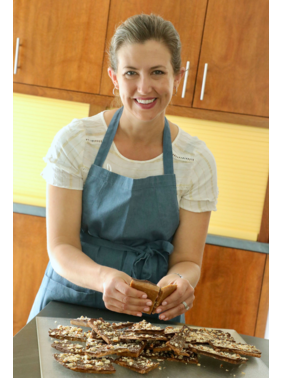
An inspirational female entrepreneur thoughtfully reviewing business plans surrounded by artisanal toffee samples.
What You'll Learn
How Katie Carrier transitioned from a finance career to launching a successful small business
The challenges and triumphs of running a home-based confectionery business
Insights into small business development and community impact
Expert advice on scaling a small business while maintaining quality and authenticity

Creative flat lay showcasing inviting toffee ingredients on a rustic kitchen table.
Overview of Katie’s Toffee: A Small Business Success Story Rooted in Tradition
Early Influences and Family Legacy in Small Business
Katie’s love for toffee can be traced back to her childhood, where family played a pivotal role in nurturing her culinary skills and entrepreneurial spirit. “I grew up in a small family business with my mom. She taught me how to make toffee when I was just eight years old, and it became my thing at every holiday,” Katie Carrier explains. This early exposure to the sentimental craft of handmade confections ignited a lifelong passion.
The family legacy not only honed her technical skills but also imparted the grit and resilience needed to navigate small business challenges. Katie’s initial hesitation to dive into an entrepreneurial path stemmed from witnessing the struggles her family endured, opting instead for the perceived security of a corporate finance career. However, the call of tradition and creativity was never far from her heart.
Transition from Corporate Finance to Entrepreneurship
After earning a finance degree and managing a bank branch in the Peninsula during a turbulent economic period, Katie realized the mismatch between her values and the corporate environment. The 2010 banking aftermath left her enforcing policies she believed were unjust, driving her to seek a more fulfilling path. Exiting finance, she embraced caregiving, becoming a licensed daycare provider for 15 years.
Yet, the enduring love for toffee-making lingered, culminating in an entrepreneurial restart during an unprecedented time. The pandemic shuttered her daycare business temporarily, prompting Katie to revive her toffee craft, initially as gifts for friends and family. Encouragement from her community quickly transformed these gifts into orders, marking the beginning of her small business success story rooted in passion and community support.
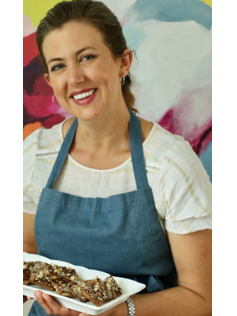
A nostalgic moment of Katie and her mother stirring caramel in a vintage kitchen, symbolizing family legacy.
The Birth of Katie’s Toffee During the Pandemic
Facing the pandemic's impact on her daycare operation, Katie's decision to channel her energy into toffee-making was both practical and inspired. Starting with a humble Facebook page in early 2021, her homemade treats quickly gained popularity, fueled by heartfelt testimonials and viral neighborhood buzz. Orders surged, compelling Katie to build a Shopify website, professionalize her operations, and create formal retail partnerships.
Her product’s charm lay in its handcrafted authenticity and rich family history — qualities that resonate deeply with customers seeking genuine, local artisanal products. Katie's toffee became more than candy; it became a symbol of resilience and small business success during challenging times.

Hand stirring rich caramel in a copper pot, highlighting the artisanal craftsmanship behind Katie’s Toffee.
Business Development and Growth: From Home Kitchen to Local Market Success
Operating a Cottage Food Business: Challenges and Rewards
Katie operates Katie’s Toffee from her home under a cottage food permit, embodying the intimate nature of a true small business success story. She crafts every batch herself, typically working late at night after her four children have gone to bed. “I do everything with a cottage permit from home, making batches at night after my kids go to bed. It’s a labor of love and dedication,” Katie shares, capturing the commitment required to balance family and business demands.
This hands-on approach ensures unmatched quality and authenticity but also sets natural limits on scale. Katie usually produces between 30 to 50 pounds of toffee daily, packaging and shipping directly from her home office, which has expanded to accommodate growing inventory. Her mother even assists with festive bow-tying, keeping the family tradition alive.
Expanding Distribution: From Facebook Orders to Over 22 Local Stores
From a simple Facebook page to local store shelves, Katie’s Toffee’s growth showcases the power of community and networking in small business success. Initial wholesale partnerships with local shops, like Silverman's and United Markets, facilitated steady sales and brand visibility. Over time, the distribution expanded to more than 22 outlets throughout the Bay Area.
Community response and repeat business fueled this expansion, fueled by Katie’s personal engagement with customers and retailers alike. She emphasizes the importance of nurturing these connections to build a sustainable, locally beloved brand.

Katie and her family celebrating their small business success, surrounded by toffee packages.
Collaborations and Corporate Gifting Opportunities
Beyond retail, Katie has expanded into corporate gifting and event collaborations, introducing her toffee as favored gifts at galas and private parties. Her partnership with charity events, like the Guide Dog Foundation gala, extends her community impact and business reach.
Preparing large corporate orders showcases her ability to maintain artisanal quality while scaling production selectively. Katie’s approach demonstrates that small business success can blend tradition with innovative growth strategies.
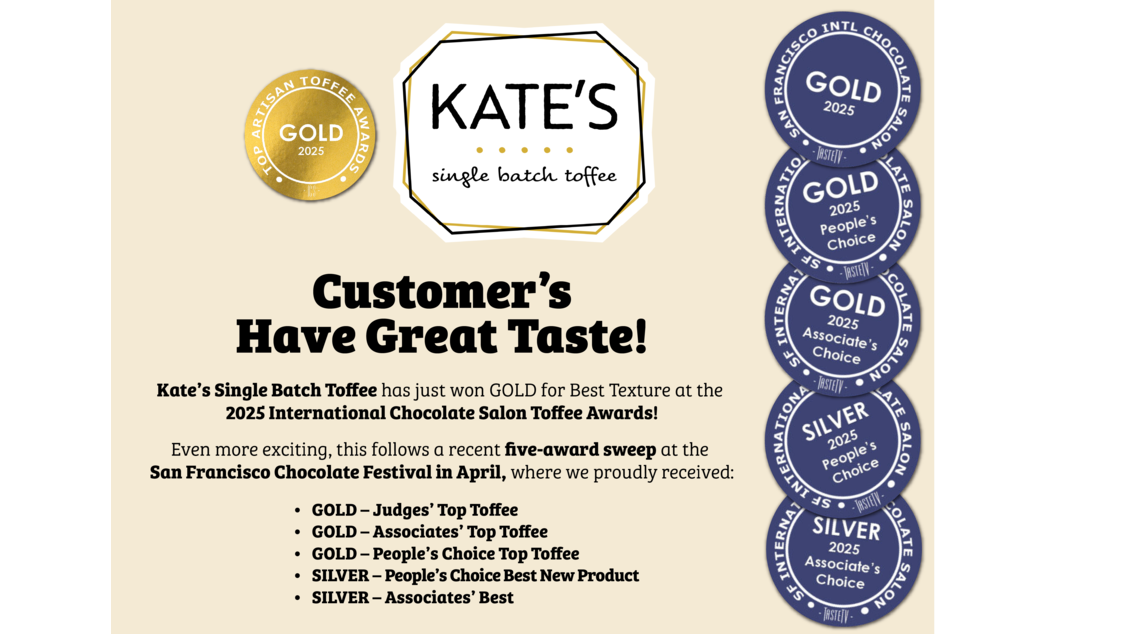
Katie packaging toffee with festive bows, a joyful moment in her growing business journey.
Expert Insights: Katie Carrier on Small Business Success and Community Impact
Maintaining Quality and Authenticity While Scaling
In Katie's opinion, maintaining the quality and personal touch is paramount even as the business grows. “The whole production is me. That’s a difficult thing to expand, but it’s important to keep the quality and personal touch,” she emphasizes. This hands-on philosophy protects the reputation of Katie’s Toffee and reinforces customer trust.
Katie’s insistence on personally overseeing production ensures each batch reflects her high standards. This dedication, while challenging, is a defining characteristic of her small business success story, proving that growth does not require sacrificing authenticity.
The Importance of Staying Local and Giving Back
Katie’s vision for the business extends beyond profitability to community involvement and legacy-building. “I want to be known as the Bay Area sweet treat, hometown famous, and to give back to our community through fundraisers and sponsorships,” she states. This community-first mindset strengthens local ties and makes Katie’s Toffee a fixture in Marin County’s cultural fabric.
Supporting local charities and youth sports teams, Katie leverages her business to enrich the broader community, exemplifying how small business success stories are often intertwined with social responsibility and passion for place.
Small Business Success Stories: Lessons from Katie’s Toffee
Overcoming Imposter Syndrome and Entering Competitions
Katie candidly discusses her initial doubts and imposter syndrome when entering competitive arenas like the Chocolate Salon event. Being the only cottage food baker among established storefronts and factories was intimidating. Yet, her courage led to remarkable triumphs, including three gold medals in toffee categories and international recognition.
This experience underscored the value of self-belief and perseverance in an entrepreneur’s journey, key components of any small business success story.
Winning Awards and Building Credibility
Winning multiple awards at renowned competitions elevated Katie’s Toffee’s reputation substantially. These accolades serve not only as validation of her craftsmanship but also as powerful marketing assets, increasing trust among new customers and retailers.
Her story exemplifies how recognition can be pivotal in building credibility and opening doors for further business opportunities.
Balancing Family Life and Business Growth
As a mother of four boys, Katie masterfully balances family responsibilities with the demands of building a thriving business. From making toffee at night to managing orders and packaging, her story highlights the unique challenges and rewards of being a mompreneur.
This balance is a defining feature of many small business success stories, illustrating how passion and perseverance can harmonize with family life.
Katie confidently engaging customers at a vibrant local market booth, embodying small business success.
Common Questions About Small Business Success
What is the most successful small business?
The most successful small businesses typically combine passion, market demand, effective management, and community connection. Katie’s Toffee exemplifies this, thriving through authentic products, strong local support, and strategic growth.
How to tell a business success story?
A compelling business success story shares the journey, highlighting challenges overcome, key milestones, and the entrepreneur’s vision. Katie’s story illustrates these elements, from her corporate departure to award-winning artisanal toffee production.
What is a success story example?
Katie’s Toffee’s rise from home kitchen batches to local market favorite, coupled with awards and community impact, serves as a vivid example of a small business success story.
What small businesses have the best success rate?
Businesses deeply connected to their community, offering high-quality or unique products, and operated with flexibility and passion, often enjoy the best success rates. Katie’s adherence to quality and local engagement aligns well with these criteria.
Key Takeaways
Key Aspects and Insights from Katie’s Toffee Small Business Success Story |
|
Key Aspect |
Insight from Katie’s Toffee |
|---|---|
Passion and Tradition |
Rooted in family recipes and personal dedication |
Adaptability |
Pivoted from daycare to toffee business during pandemic |
Community Focus |
Strong local support and giving back |
Quality Control |
Maintains hands-on production for authenticity |
Growth Strategy |
Scaling carefully with plans for commercial kitchen |
Conclusion: Embracing the Small Business Success Story with Heart and Hustle
Final Thoughts on Katie’s Journey and Inspiration for Aspiring Business Owners
Katie Carrier’s story is an inspiring testament to the power of passion, perseverance, and community in shaping a successful small business. Her journey from a finance career to making handcrafted toffee demonstrates that true fulfillment and business achievement often come from following one’s authentic calling.
By cultivating quality, embracing local roots, and balancing life’s challenges, Katie offers invaluable lessons for entrepreneurs everywhere. As she encourages, “If you want anything done, ask a busy parent. You can make it work with passion and perseverance.” This powerful sentiment captures the heart of her small business success story — one shaped by love, hard work, and unwavering commitment.
Contact Kate at katestoffee@gmail.com or visit Katestoffee.com
Support local small businesses like Katie’s Toffee by visiting their website or local stores
Share your own small business success story to inspire others
Subscribe for more inspiring business success stories and expert insights
 Add Row
Add Row  Add
Add 

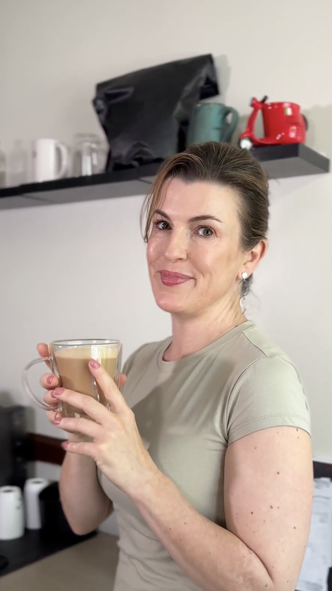
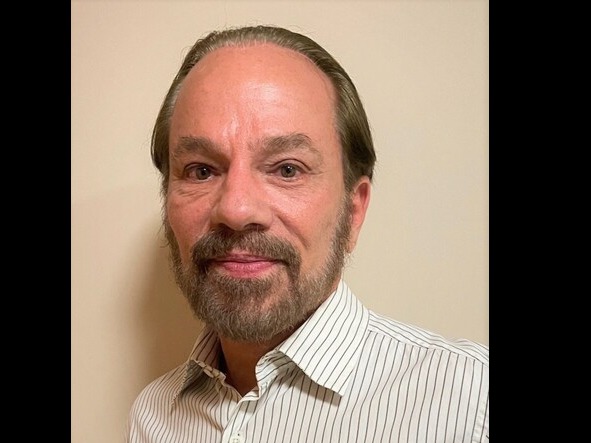
Write A Comment